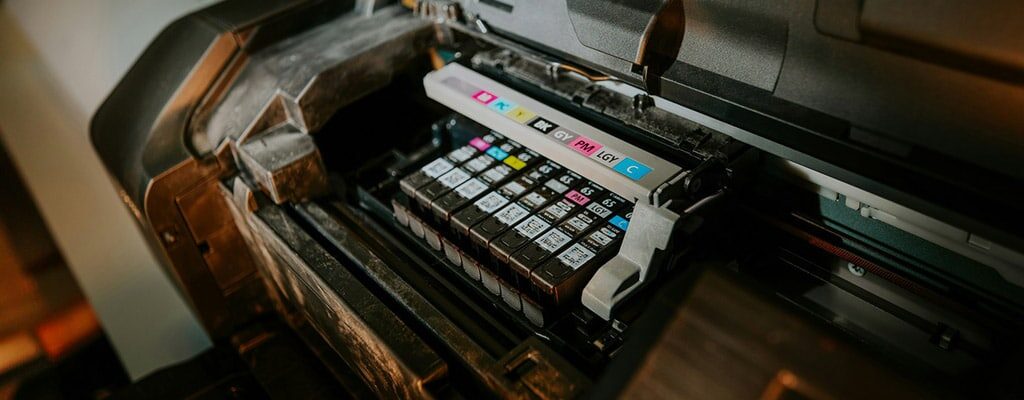Can I Replace the Printheads on a Wide-Format Printer?
Contents
Office printers have long earned their place as the most temperamental devices in just about any office. They break down, they jam, they output the wrong colors, and occasionally do other strange, inexplicable things. So does that mean that all you have to do is replace printheads on printer and you’re good to go? Not quite, but that is a start.
Today’s most sophisticated printers are much better than their counterparts of the last decade. But even in high-volume production print settings with multimillion-dollar equipment, paper jams still happen.
Wide-format printers commonly found in graphic design studios and architecture firms are generally held to a higher standard. But that doesn’t mean they are exempt.
Environmental issues, filtration obstacles, and encoder system failures can all take their toll on even the best printers. As a result, print process owners, architects, and other wide-format printer users often find themselves looking for quick fixes to tough problems, like replacing faulty print heads inside their defective devices.
Understanding Your Wide-Format Printheads
Print heads are the most sensitive and integral components to repair in most wide-format printers. A single HP printhead contains six precision-aligned silicon chips with thousands of tiny nozzles each.
These tiny nozzles push the ink out of the cartridge and onto the paper with unprecedented speed and precision. Consider the fact that an HP PageWide print head contains six chips with 6,336 nozzles each – that’s 25,344 nozzles in a device that fits in your hand. Each nozzle is about one-fifth the diameter of a single strand of human hair.
The typical wide-format printer operating at 1200 DPI will perform billions of shots to produce a single image. The plus side of having such a high density of nozzles on each chip is that individual chip failures are not so important – if the system catches them in time.
HP printers use optical drop detectors – cameras sensitive enough to see individual ink drops in flight – to check thousands of individual nozzles every second. The printer can identify bad nozzles and quarantine them, preventing ink spills, banding, white streaks, and other artifacts.
If you print at the maximum resolution of 2400 DPI, the system works harder and slower to get the job done just right. This is why HP T-series printers feature Draft Mode. In Draft Mode, users can print quick, efficient monochrome documents at 300 to 600 DPI.
How to Replace Printheads on a T-Series Printer
If you use your T-series Draft Mode whenever you don’t need ultra-high-definition results, you will effectively maximize the lifespan of your print heads. Years may pass before you need to seriously consider replacing them.
However, if you have consistent, regular need of maximum-DPI full-color wide-format printing, then you may need to replace the printer heads of your HP T-Series printer more often.
Fortunately, HP produced an easy-to-follow tutorial video showing how to remove the old printhead and replace it with a new one on the HP T920, T1500, and T2500 wide-format printers. Simply access the “Printhead” menu from your device’s touchscreen interface settings and tap on “Replace Printhead.”
The carriages will move to one side and stop moving. Once it does, you can lift the cover lever and disengage the carriage latch to enable access to the printhead. Push on the two blue-colored snap fasteners on each side to remove it.
Putting in the new print head is just as simple. However, take care not to expose the new printhead to air before installing. By necessity, printer ink dries upon contact with air. If ink dries inside any of those thousands of tiny nozzles, they will instantly be rendered unusable.
HP PageWide Printers Don’t Need Draft Mode
While the HP T-series is a powerful and valuable tool for wide-format printing, they take a backseat to the HP PageWide series when it comes to cost-effectiveness and user-friendliness. For instance, there is no draft mode because the PageWide prints just as efficiently at 1200 DPI as it does at 300 DPI – there is no need for a draft mode.
Similarly, PageWide printers are able to print color documents with the same cost per page as monochrome documents, without any difference in production print speed. This effectively levels the playing field for all types of wide-format prints and hugely reduces the chance users will ever have to replace its print heads.
With water-resistant pigment-based ink and compatibility with waterproof media types, the PageWide is quickly becoming the new standard for construction and architecture prints around the world. It is gaining an especially strong foothold in areas that suffer from heavy rainy seasons.
It’s almost guaranteed that your on-site construction print gets wet under rainy conditions. Protect your investment using the latest HP technology and reap the rewards of efficient, cost-effective printing.
Have you replaced your print heads for the last time? Contact Kelley Create and ask us about deploying HP PageWide technology on your site.



